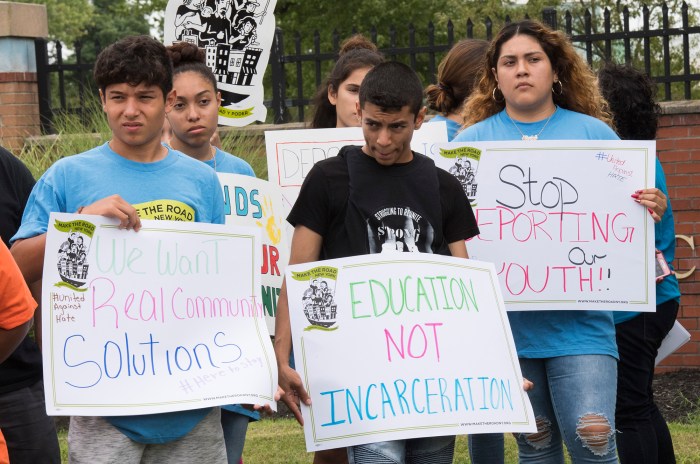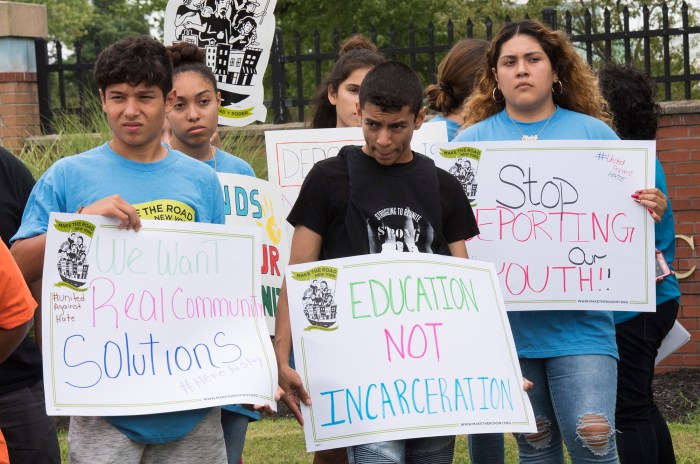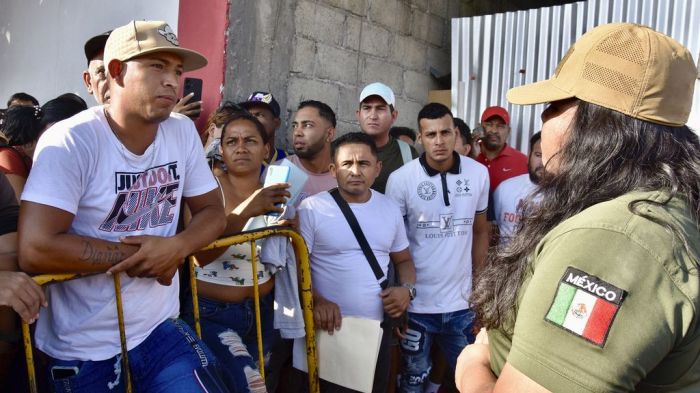
How schools are navigating Trump immigration policies sets the stage for a deep dive into the complexities of adapting educational systems to changing legal landscapes. This exploration reveals the diverse approaches schools are taking to accommodate students impacted by these policies, from those with DACA status to undocumented students. We’ll examine the financial, logistical, and emotional challenges schools face, along with the creative solutions being implemented by communities to support immigrant students.
The article will detail the varied impacts on school policies, encompassing student enrollment, resource allocation, and the potential consequences for students, families, and staff. It will also delve into the challenges schools face, from legal ambiguities to the emotional toll on students and staff. Furthermore, the role of community organizations and parents in advocating for immigrant students will be highlighted.
Finally, the article will explore the educational outcomes and future implications, including recommendations for policy changes and strategies for fostering inclusivity.
Impact on School Policies

Navigating the complexities of immigration policies has presented unique challenges for schools across the nation. Schools are increasingly tasked with providing support for students from diverse backgrounds, while also complying with federal regulations and local laws. The varying approaches taken by different districts highlight the multifaceted nature of this issue, impacting not only student success but also school funding and resource allocation.
Enrollment and Immigration Status Policies
Schools are actively adapting their enrollment procedures to accommodate students with varying immigration statuses. This often involves streamlining the documentation process to avoid unnecessary barriers to enrollment. Some districts are creating dedicated intake teams or using standardized forms to streamline the process, ensuring compliance with federal regulations while maintaining a supportive environment. The aim is to ensure that the process is transparent, efficient, and minimizes the burden on families.
Accommodation for Students with DACA or Undocumented Status
Schools are implementing diverse strategies to support students with Deferred Action for Childhood Arrivals (DACA) status or those who are undocumented. These strategies range from providing access to counseling services and academic support to offering English as a Second Language (ESL) programs and culturally responsive instruction. Some districts are exploring waivers or accommodations to ensure equal access to extracurricular activities and school-sponsored events.
A common thread is to prioritize a student’s well-being and create a sense of belonging.
Specific Policies Implemented by School Districts
Several school districts have implemented specific policies to address the challenges posed by immigration policies. For instance, some districts have created separate student support teams to handle the unique needs of immigrant students, focusing on providing resources for both academic and emotional support. Others have implemented comprehensive multilingual support systems, including interpreters and bilingual staff. There are also examples of districts that have partnered with community organizations to provide additional resources to immigrant families.
Impact on School Funding and Resource Allocation
The implementation of these policies has a direct impact on school funding and resource allocation. Increased demands for support services, such as ESL programs and counseling, often require additional funding. This may involve re-allocating existing resources or seeking external grants and partnerships. The potential for increased costs associated with these accommodations needs careful consideration to ensure that overall educational quality is maintained.
Consequences for Students, Families, and Staff
The implementation of these policies can have various consequences for students, families, and staff. For students, this may include improved access to education and support, fostering a sense of belonging and reducing anxiety. Families might experience reduced stress related to navigating school procedures and increased access to resources. Conversely, some staff members may feel overwhelmed by the demands of implementing these policies, requiring additional training and support.
The potential positive and negative consequences necessitate a comprehensive approach to ensure equitable access to quality education for all students.
Comparison of School District Approaches
| District Approach | Description | Impact on Funding | Potential Consequences |
|---|---|---|---|
| Providing Support Services | Increased resources for counseling, ESL, and cultural support. | Potentially higher costs, but potentially offset by reduced dropout rates and increased student success. | Improved student well-being, reduced stress for families, and potentially improved academic performance. Staff may need additional training and support. |
| Using Waivers | Allowing students to participate in extracurricular activities or programs without specific documentation requirements. | Potential for limited impact on funding, but could increase participation in school activities. | Increased access to school activities, but may raise concerns about compliance with regulations. |
| Limiting Access | Restricting access to specific programs or services based on immigration status. | Potentially lower costs, but likely to have negative consequences on student well-being and educational attainment. | Reduced access to educational opportunities and potentially negative impact on student well-being and school climate. |
Challenges Faced by Schools
Navigating the complexities of immigration policies presents unique and multifaceted challenges for schools. Beyond the immediate logistical hurdles, the emotional and educational needs of immigrant students and their families require sensitive and proactive responses. These policies often create a ripple effect, impacting not only students but also teachers, staff, and the overall school community.Schools are increasingly tasked with supporting students with diverse backgrounds and experiences, often without the necessary resources or training.
The financial, emotional, and logistical strains are significant, requiring schools to adapt and innovate in order to provide equitable education for all.
Legal Ambiguities and Potential Discrimination, How schools are navigating trump immigration policies
Schools face considerable legal uncertainty when implementing immigration policies. The evolving legal landscape surrounding immigration status can lead to ambiguities in school policies and procedures. This uncertainty can create a climate of fear and distrust, potentially hindering students’ access to resources and support. It’s crucial to clearly differentiate between immigration status and academic performance, ensuring that students are treated fairly and equitably.
Schools need to be vigilant in preventing discriminatory practices against students based on their perceived immigration status. This involves ongoing training for staff and a clear understanding of applicable laws.
Financial Burdens
The influx of immigrant students can strain school budgets. Increased student populations often lead to higher costs associated with classroom supplies, resources, and support services. Schools may also face additional expenses for providing specialized language support, cultural sensitivity training, and mental health services. The needs of immigrant students, including those requiring translators or specialized learning accommodations, can significantly impact school budgets.
For example, a school with a sudden increase in English language learners might require additional funding for ESL teachers and materials. Likewise, providing mental health support for students experiencing trauma related to immigration processes can also place a considerable financial burden on the school.
Emotional Toll on Students, Families, and Staff
Immigration policies can have a profound emotional impact on students, families, and staff. Students may experience anxiety, fear, and isolation due to uncertainty surrounding their legal status. Families may face stress and hardship related to separation, relocation, and cultural adjustment. Teachers and staff may experience emotional strain as they attempt to support students and families navigating complex situations.
It’s essential for schools to establish support systems for all stakeholders. This includes creating a safe and welcoming environment where students and families feel supported and understood. Crisis intervention and counseling services can also be essential.
Teacher Training and Professional Development
Providing adequate support for immigrant students requires specific training and professional development for teachers and staff. This includes training on culturally responsive teaching practices, effective strategies for supporting English language learners, and understanding the specific needs of students who have experienced trauma. Effective training equips teachers to provide high-quality instruction that addresses the diverse learning needs of immigrant students.
This also involves ongoing professional development that addresses the evolving legal and social context surrounding immigration.
Geographic and Demographic Variations
The challenges faced by schools vary considerably based on geographic location and demographics. Schools in border areas or those with high concentrations of immigrant students may experience more significant financial and logistical burdens. Schools in urban areas often face different challenges related to resources and access to services than rural schools. The specific cultural backgrounds and needs of immigrant students can also vary greatly, impacting the types of support required.
Navigating Trump’s immigration policies has presented unique challenges for schools, forcing them to adapt their practices and support systems. The complex legal landscape has led to a need for careful consideration of student needs and resources. For instance, schools are now more keenly aware of the importance of providing culturally sensitive support for students and families, as well as legal guidance for those impacted by the policies.
Research from figures like victor ambros gary ruvkun highlights the need for comprehensive solutions that address both the practical and emotional impacts of these policies. Ultimately, schools are striving to create inclusive and supportive environments for all students, regardless of their immigration status.
For example, a school in a rural area with a large influx of Hmong students might need to provide specialized cultural support services and materials not readily available in a school serving predominantly English-speaking students.
Table of Common Legal and Logistical Hurdles
| Challenge | Description | Possible Solutions |
|---|---|---|
| Legal Ambiguity | Uncertainty surrounding immigration laws can create confusion regarding student eligibility for services. | Establish clear protocols for determining eligibility, consult with legal experts, and update policies as laws change. |
| Limited Resources | Schools may lack the necessary funding or personnel to adequately support immigrant students. | Seek grants, explore partnerships with community organizations, and advocate for increased funding for immigrant student support programs. |
| Lack of Cultural Sensitivity Training | Teachers and staff may not be adequately prepared to work with students from diverse cultural backgrounds. | Implement culturally responsive teaching training programs, utilize culturally relevant materials, and encourage staff to engage with the community. |
| Potential for Discrimination | Students may face prejudice or bias based on their perceived immigration status. | Foster a school climate of inclusivity and respect, establish clear anti-discrimination policies, and conduct regular staff training on equity and inclusion. |
Community Responses and Advocacy

Beyond the policies themselves, the heart of the immigrant student experience lies in the collective response of communities. Schools, often caught in the crosscurrents of legal mandates and humanitarian concerns, rely heavily on the engagement and advocacy of community organizations and parents to navigate these complex situations. This crucial support network is vital for ensuring that immigrant students receive the resources and understanding they need to thrive.Community organizations and parents are not passive recipients in this process; they are active agents of change.
Navigating Trump’s immigration policies has presented a unique set of challenges for schools, forcing them to adapt their practices and procedures. It’s fascinating to consider how these policies impact the educational landscape, and the complexities involved are mirrored in some of the most challenging questions in Jeopardy’s history, according to AI here. Ultimately, schools are constantly working to create inclusive and supportive environments for all students, regardless of their immigration status.
Their engagement ranges from providing direct support to influencing policy, highlighting the crucial role of collective action in shaping the educational landscape for immigrant children. Their dedication underscores the strength and resilience of communities that embrace diversity.
Roles of Community Organizations in Supporting Schools
Community organizations play a multifaceted role in supporting schools during periods of policy change, providing vital resources and advocating for the rights and needs of immigrant students. Their efforts extend from direct services to policy reform. Their multifaceted approach is crucial for addressing the unique challenges faced by immigrant students.
- Direct Support Services: Many organizations offer direct support to immigrant families, providing translation services, legal aid, cultural orientation programs, and mental health resources. This immediate assistance can be crucial for families navigating a new country and system, and it can reduce the immediate stress on families.
- Advocacy and Policy Reform: Community organizations often engage in advocacy efforts, lobbying for policy changes that better serve immigrant students. This can involve grassroots campaigns, public awareness campaigns, and meetings with policymakers. Their influence can be significant, particularly when backed by the collective voices of families.
- Collaboration and Partnership Building: Community organizations often act as a bridge between schools and families, facilitating communication and cooperation. They foster a sense of community and shared responsibility, empowering both schools and families to work together to support immigrant students.
Successful Community Initiatives
Numerous successful community initiatives have emerged in response to shifting immigration policies. These initiatives showcase the power of collective action in creating supportive environments for immigrant students.
- Parent-Teacher Associations (PTAs) and School Councils: Active PTAs and school councils often take the lead in organizing fundraising efforts to provide essential resources like school supplies, tutoring programs, or even culturally relevant learning materials. They can also play a key role in fostering a welcoming school environment through events and programs that celebrate diversity.
- Community-Based Organizations: Groups like immigrant advocacy centers, legal aid organizations, and social service agencies provide vital resources, including legal assistance, language support, and referrals to crucial social services. Their expertise and network of resources are crucial in navigating the complex legal and administrative systems involved.
- Volunteer Programs: Volunteering can take many forms, from tutoring and mentoring to providing translation services. The dedication of volunteers plays a crucial role in ensuring that immigrant students have access to the support they need to succeed academically and socially.
Differing Perspectives within Communities
Communities are not monolithic; different groups within them hold diverse perspectives and priorities regarding immigrant students. Understanding these differing viewpoints is essential for effective advocacy.
| Perspective | Priority | Example |
|---|---|---|
| Economic Concerns | Maintaining fiscal stability and resources | Concerns about the cost of educating immigrant students or the potential strain on public resources. |
| Social Concerns | Preserving cultural norms and values | Concerns about the impact of immigration on existing social structures or the integration of immigrant students into the community. |
| Humanitarian Concerns | Supporting individuals and families | Prioritizing the well-being of immigrant students and families, often emphasizing the importance of providing educational opportunities and support services. |
Educational Outcomes
Navigating the complexities of immigration policies has a profound impact on the educational journey of immigrant students. The emotional and academic well-being of these students is directly tied to the policies and support systems in place. This section will delve into the effects of various immigration policies on student performance, explore strategies for equitable access, and highlight successful programs designed to support these students.
Impact on Academic Performance and Well-being
Immigrant students face unique challenges, including language barriers, cultural adjustments, and potential anxieties stemming from the immigration process itself. These factors can significantly affect their academic performance and emotional well-being. Research consistently demonstrates a correlation between a student’s emotional stability and their ability to focus on academics. Students experiencing trauma or fear often struggle to concentrate in the classroom, potentially hindering their academic progress.
Comparison of Educational Outcomes Under Different Policies
Examining the educational outcomes of immigrant students under varying immigration policies reveals important patterns. For example, policies that prioritize integration and provide language support have been shown to correlate with higher academic achievement and increased student well-being. Conversely, policies that create a climate of fear or uncertainty often lead to decreased academic performance and increased stress levels among immigrant students.
Comparing outcomes across different regions and time periods, considering the policies in place during those times, can help us identify which approaches yield the best results.
Strategies for Equitable Access to Education
Schools employ various strategies to ensure equitable access to education for immigrant students. These strategies often include specialized language acquisition programs, culturally responsive teaching methods, and the implementation of trauma-informed practices. Such initiatives aim to address the diverse learning styles and needs of these students, ensuring they feel supported and understood in their learning environment.
Support Services for Students Affected by Immigration Policies
Providing comprehensive support services is crucial for immigrant students navigating the challenges associated with immigration policies. This includes offering tutoring and mentoring programs, providing access to counseling services, and creating supportive school environments. These services aim to address the specific needs of these students, helping them overcome obstacles and thrive academically. These support services are particularly vital for students experiencing anxiety or trauma related to immigration.
Examples of Successful Programs
Several schools have implemented successful programs designed to assist immigrant students in their academic journey. These programs often involve partnering with community organizations, offering bilingual instruction, and incorporating cultural sensitivity into the curriculum. One example involves providing academic support through a bilingual program in elementary schools, fostering an inclusive learning environment where students feel comfortable learning and succeeding.
Another model is creating a peer mentoring program where immigrant students can connect with other students who understand their experiences.
Navigating Trump’s immigration policies is a real headache for schools, right? It’s a complex web of shifting rules and uncertainty, making it tough to plan for student needs. Meanwhile, the recent events surrounding the shooting at the Israeli Embassy in DC, and the reactions from politicians, as seen in this article , highlight the wider political landscape.
All this impacts the delicate balancing act schools are trying to maintain when it comes to supporting immigrant families and students.
Correlation Between School Policies and Student Achievement
| School Policy | Description | Potential Impact on Student Achievement |
|---|---|---|
| Bilingual Education Programs | Offer instruction in two languages | Improved language acquisition, increased engagement, and higher test scores |
| Cultural Sensitivity Training for Teachers | Educate teachers about diverse cultural backgrounds | Improved classroom climate, fostering a more inclusive learning environment, and higher student engagement |
| Trauma-Informed Practices | Acknowledge and address potential trauma | Reduced anxiety, improved focus, and increased academic performance |
| Mentorship Programs | Pair students with mentors | Increased academic support, social connections, and improved well-being |
This table illustrates potential trends and patterns between school policies and student achievement. The relationship is complex, and these are just a few examples. Further research is necessary to identify specific correlations and causal relationships.
Future Implications and Recommendations: How Schools Are Navigating Trump Immigration Policies
The legacy of past immigration policies, particularly those enacted during the Trump administration, continues to cast a long shadow over the educational landscape. These policies, often fraught with challenges and inconsistencies, have significantly impacted the experiences and opportunities of immigrant students, demanding careful consideration of their future implications and proactive strategies to mitigate potential harm. A commitment to creating inclusive and supportive learning environments for all students is paramount, requiring a multifaceted approach that encompasses policy changes, community engagement, and ongoing research.
Potential Long-Term Effects on the Educational Landscape
The long-term effects of these policies are multifaceted and potentially detrimental. Disruptions to educational continuity, anxieties about family separation, and the erosion of trust in the educational system can have lasting consequences on student well-being and academic performance. For instance, the fear of deportation or the trauma associated with immigration procedures can significantly affect a student’s ability to focus on learning.
Furthermore, the lack of access to crucial resources and support services can hinder academic progress and create systemic inequities.
Recommendations for Policy Changes
To improve the situation for immigrant students, several policy changes are crucial. These include increasing access to legal aid and support services for families navigating immigration processes. Furthermore, funding dedicated to supporting immigrant students’ needs in schools is essential. This includes providing bilingual education programs, culturally responsive instruction, and mental health services. Policies that streamline the process for students to access necessary documentation and services, such as providing expedited pathways to student visas and streamlined processes for reporting, can also reduce barriers to access.
Framework for a More Inclusive and Supportive Environment
Fostering an inclusive environment for all students requires a proactive approach. This includes promoting culturally responsive pedagogy in classrooms, encouraging teachers to understand and address the specific needs of immigrant students, and developing culturally sensitive curricula that reflect the diversity of the student body. Creating welcoming school environments that acknowledge and respect the backgrounds of all students is critical.
This includes establishing clear anti-discrimination policies, promoting inclusivity through school-wide initiatives, and providing resources for students and families to access support services.
Collaboration Strategies with Community Groups and Legal Professionals
Effective collaboration is essential. Schools should actively engage with community organizations and legal professionals who can provide vital support and guidance to immigrant families. This includes forming partnerships with immigration advocates, legal aid organizations, and community centers to create a support network for students and families. Furthermore, clear communication channels should be established to ensure information is readily available and accessible to all stakeholders.
This includes providing translated materials and resources in multiple languages.
Importance of Ongoing Dialogue and Research
Continuous dialogue and research are critical for understanding the evolving needs of immigrant students. Researchers, educators, and policymakers should collaborate to gather data and information on the impact of immigration policies on educational outcomes. This ongoing research should inform policies and practices that effectively support immigrant students. This includes conducting studies on the effectiveness of specific interventions, tracking the academic progress of immigrant students, and monitoring the impact of immigration policies on school climate.
Proposed Solutions and Their Potential Benefits and Drawbacks
| Proposed Solution | Potential Benefits | Potential Drawbacks |
|---|---|---|
| Increased funding for bilingual education programs | Improved academic achievement for ELL students, enhanced language skills, improved cultural understanding. | Potential for increased costs, need for qualified bilingual teachers, potential for uneven distribution of funding. |
| Dedicated mental health support services for immigrant students | Reduced stress and anxiety, improved emotional well-being, improved academic performance. | Potential for shortage of mental health professionals, need for culturally competent therapists, potential for stigma associated with seeking help. |
| Streamlined processes for accessing documentation and services | Reduced barriers to access for immigrant students, increased participation in school activities, improved academic performance. | Potential for bureaucratic hurdles, need for clear guidelines and procedures, potential for delays in processing. |
Ending Remarks
In conclusion, the complexities of how schools are navigating Trump immigration policies underscore the urgent need for equitable and supportive educational environments for all students. The challenges and successes highlighted in this exploration demonstrate the vital role of schools, communities, and advocates in ensuring the academic and social well-being of immigrant students. Ultimately, the long-term implications of these policies necessitate ongoing dialogue and research to inform future strategies for fostering inclusivity and academic success.







